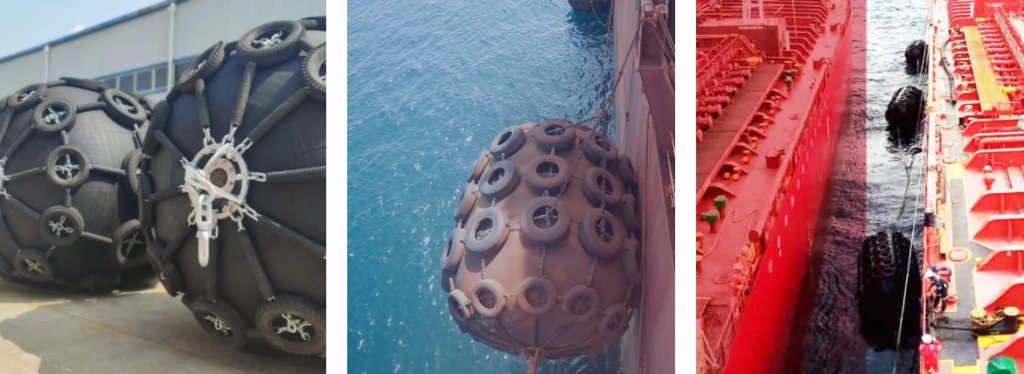Mengapa Memilih Fender Donat untuk Sistem Perlindungan Monopile?
07/01/2025Bagaimana cara menyimpan spatbor karet?
07/02/2025Fender Sel vs Fender Pneumatik: Mana yang Tepat untuk Anda?
1. Mengapa Ini Penting - Dan Mengapa Sekarang
Insiden tabrakan dan meningkatnya biaya perawatan memaksa operator kapal dan pelabuhan untuk memikirkan kembali pilihan fender. Bayangkan sebuah terminal kapal pesiar yang sibuk di San Francisco, di mana pergeseran pasang surut dan lalu lintas yang tinggi meningkatkan permintaan akan fender kapal. Memilih opsi yang salah - misalnya, fender sel yang tidak cocok untuk gerakan konstan - menyebabkan keausan dini, penggantian yang mahal, dan penundaan operasional. Dengan anggaran yang ketat dan waktu henti yang mahal, memilih yang tepat fender laut dan fender kapal sangat mendesak.
2. Sekilas tentang Perbandingan Cepat
Fender Sel: Silinder karet dengan ruang berongga-penyerapan energi yang sangat baik dan gaya reaksi yang rendah, ideal untuk tempat berlabuh tugas berat.
Fender Pneumatik: Unit tipe Yokohama yang dapat ditiup - mudah beradaptasi, mengapung bebas, terjangkau dalam jangka pendek, cocok untuk STS dan pasang surut yang bervariasi.
3. Menyelami Lebih Dalam Setiap Jenisnya
Fender Sel: Tugas Berat, Penyerapan Energi Tinggi
- Performa & daya tahan tinggi: Fender sel memiliki "penyerapan energi yang unggul dan gaya reaksi yang rendah," sehingga ideal untuk terminal minyak, pelabuhan peti kemas, dan operasi LNG.
- Tekanan lambung rendah: Desain sel berongga mereka menawarkan distribusi beban yang seragam di seluruh lambung dan tempat berlabuh.
- Bangunan yang kuat: Tahan terhadap cuaca, UV, dan abrasi-ideal untuk pemasangan permanen.

Fender Pneumatik: Fleksibel & Hemat Biaya
- Portabel dan mudah digunakan: Mengembang/mengempis dengan mudah, ideal untuk tempat berlabuh sementara atau tempat berlabuh darurat.
- Gaya reaksi lunak, ramah STS: Bantalan yang sangat baik selama transfer antar kapal dan pergeseran pasang surut yang besar.
- Ekonomi: Biasanya sekitar ⅓ biaya unit busa atau sel untuk ukuran yang sama.

4. Sekilas tentang Pro & Kontra
| Fitur | Fender Sel | Fender Pneumatik |
|---|---|---|
| Penyerapan energi | Sangat tinggi, ideal untuk sandar berat | Tinggi, tetapi sedikit kurang efisien per ukuran |
| Gaya reaksi | Rendah dan konsisten | Sangat rendah pada beban ringan; meningkat di bawah beban |
| Daya tahan | Sangat baik, umur pemakaian yang panjang | Bagus, tetapi rentan terhadap tusukan |
| Pemeliharaan | Pemeriksaan visual; jarang diservis | Pemeriksaan inflasi tahunan; memperbaiki tusukan |
| Biaya awal | Investasi di muka yang lebih tinggi | Hemat biaya |
| Portabilitas | Instalasi tetap | Mudah diangkut dan dapat digunakan kembali |
5. Mana yang Harus Anda Pilih?
Pilih Fender Sel jika Anda membutuhkannya:
- Instalasi jangka panjang di terminal yang sibuk
- Menangani kapal besar (curah, kontainer, minyak)
- Tekanan lambung yang minimal dan kinerja yang konsisten
Pilihlah Fender Pneumatik jika kau mau:
- Fleksibilitas untuk operasi antar-kapal atau keadaan darurat
- Solusi jangka pendek hingga menengah yang terjangkau
- Opsi penerapan cepat untuk kondisi pasang surut yang berubah-ubah
6. Rangkuman
Memilih yang tepat fender kapal atau fender laut bermuara pada kebutuhan operasional. Pilih fender sel untuk ketahanan dan kinerja dalam pengaturan permanen; gunakan fender pneumatik untuk fleksibilitas dan portabilitas yang hemat biaya. NANHAI mengkhususkan diri pada keduanya-siap membantu Anda mencocokkan solusi yang tepat dengan kebutuhan dermaga Anda.
PERTANYAAN YANG SERING DIAJUKAN
1. Untuk apa spatbor laut digunakan?
Fender kapal melindungi kapal, kapal, dan infrastruktur pelabuhan dengan menyerap dan membuang energi kinetik selama berlabuh, mencegah kerusakan pada lambung dan struktur.
2. Apakah spatbor sel lebih baik daripada spatbor pneumatik?
Fender sel unggul dalam pemasangan tetap, menangani kapal berat dengan penyerapan energi tinggi dan gaya reaksi rendah. Fender pneumatik menawarkan fleksibilitas, portabilitas, dan biaya yang lebih rendah - ideal untuk operasi antar-kapal dan variasi pasang surut.
3. Bagaimana cara kerja spatbor pneumatik (Yokohama)?
Mereka menyerap benturan melalui udara bertekanan di dalam bodi karet. Gaya reaksinya yang rendah pada defleksi ringan membuatnya ideal untuk operasi kargo cair dan transfer STS.
4. Berapa umur fender sel?
Fender sel tetap biasanya bertahan antara 10 hingga 20 tahun, tergantung pada frekuensi berlabuh dan paparan lingkungan.
5. Dapatkah spatbor sel dan pneumatik digunakan bersamaan?
Ya, keduanya sering digabungkan: spatbor sel untuk docking permanen, dengan spatbor pneumatik yang ditambahkan untuk operasi yang fleksibel, sementara, atau antar-kapal.
Beri tahu saya jika Anda ingin info lebih lanjut tentang fender laut, fender kapalatau solusi dari NANHAI!
